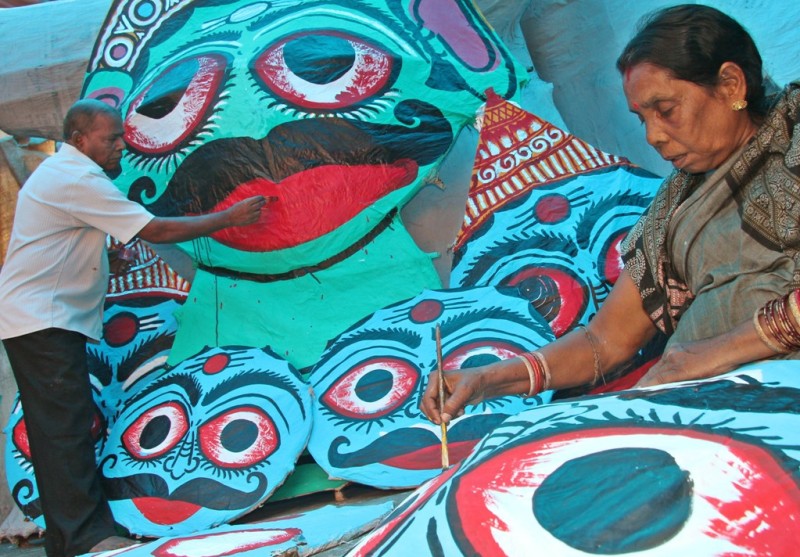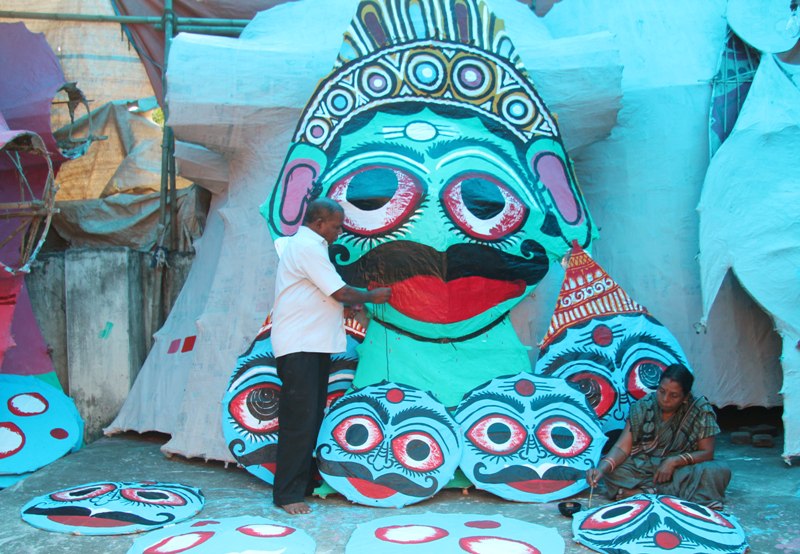Meet the makers of demon king Ravana
For 56-year-old Subharani Mohapatra, the demon king Ravana brings good fortune. At her house at Badheibanka in Bhubaneswar, heads of the famous antagonist and his brother Kumbhakaran’s life-size frames made out of bamboo sticks lie scattered all over, waiting to be dispatched to puja committees for Ravana Podi that marks the triumph of good over evil on Vijayadashami. Her deft hands have been giving shape to the demon king’s curly moustache, broad lips and bulging eyes for the last two months.

Her husband Rajkishore, son Ajit and daughters Madhu, Rashmita, Sasmita and Nishigandha help Subharani in bringing Ravana alive. Around 20 Ravana effigies are to be torched in Bhubaneswar on Vijayadashami this times and eight of them have been prepared by Subharani alone. While the tallest one is a 50-foot effigy that has been ordered by Damana Puja Committee, the smallest one is of 30 feet that will be procured by Gandamunda Puja Committee.
“I started making Ravana effigies almost 20 years ago as a hobby. Now my family enjoys making them as much as people do while burning them,” says Subharani, who made her first effigy when she was just 16-year-old and sold it for Rs 1000 then. After her marriage, she learnt art from Gauri Handicrafts, an art school in Old Town, and started making the effigies professionally. “Initially, I started with 20-foot ones, but after my husband who is also an artist decided to help me, we increased the size of the effigies over the years,” she says. The largest effigy made so far by Subharani and Rajkishore is a 70-foot one.
“We begin work around August end. The bamboo sticks are procured from outskirts of Bhubaneswar and they are torn apart and tied together to make the skeleton of Ravana. We also buy discarded silk sarees from the dealers selling second-hand goods to cover the frames. My children help in colouring and decorating the effigies,” she says.

Subharani adds the effigies are mainly prepared from bamboo, cardboard and straw. Price of each effigy varies from Rs 20,000 to Rs 25,000 depending upon the height and decorative materials used. The family tries to bring modifications in the look of the effigies every year. “This time, we have fixed red lights in the eyes and tongue for some of our effigies, so that they glow in the dark and look scarier,” says Rajkishore. Some effigies also have horns, eyelashes fixed with lights and tusks.
While the couple has other occupations like painting and preparing items related to puja paraphernalia to fall back upon the rest of the year, their son Ajit is an MBA. Their daughters are pursuing graduation and professional courses from various colleges in Bhubaneswar. “This is the only time in the year, when all of us come together to prepare Ravan effigies. When Dussehra is a week away, we bring in 10 labourers from Old Town to fix the Ravana and Kumbhakaran heads to the bamboo frames. At the puja pandals where they will be set afire, the effigies are stuffed with fire crackers,” says 23-year-old Ajit.
Also read
Bestselling author Anand Neelakanthan on his latest ‘Rise of Kali’ & why Duryodhana fascinates him

OMG-inducing, share-compelling, like-attracting, clutter-breaking, thought-provoking, myth-busting content from the country’s leading content curators. read on...
